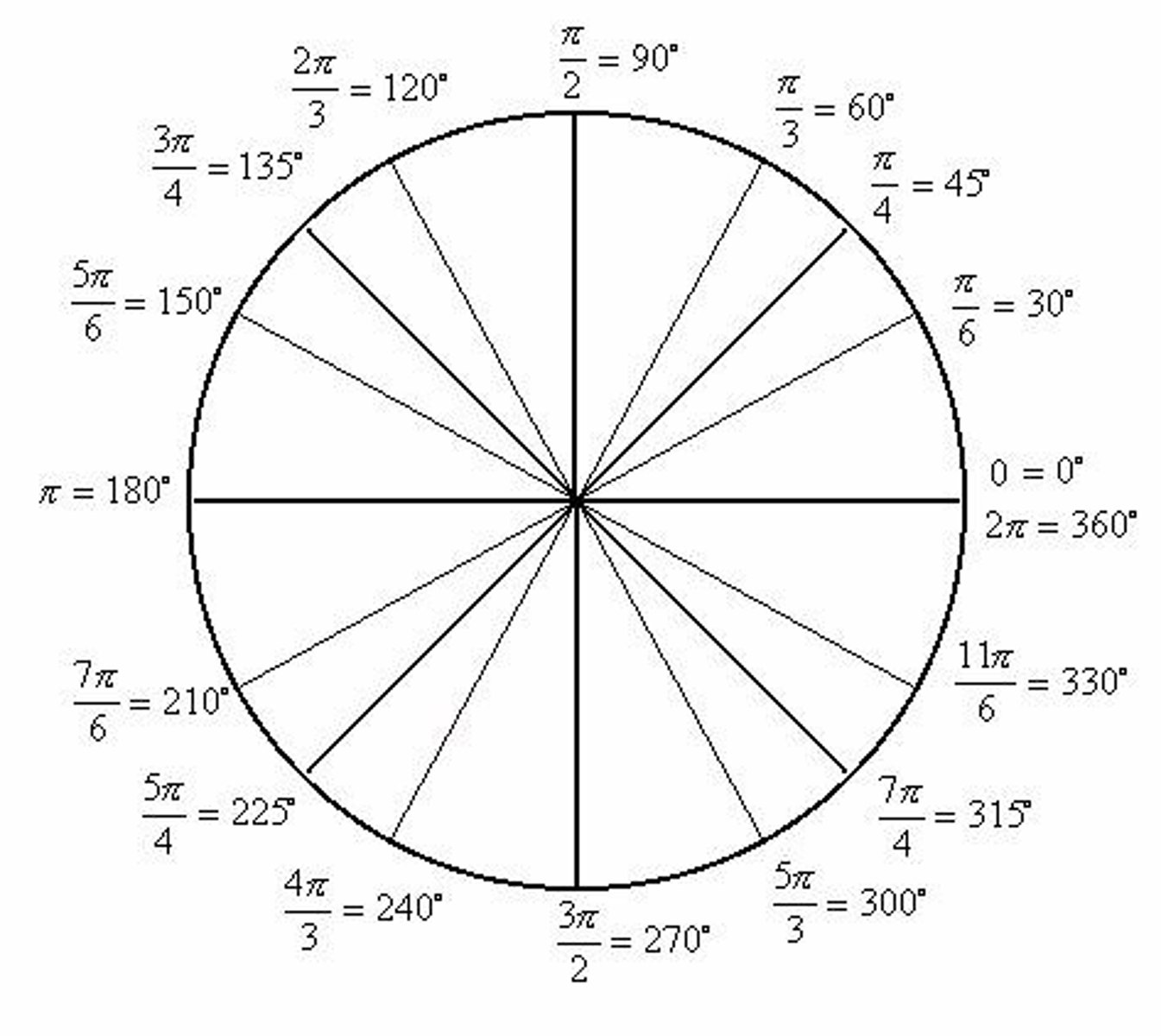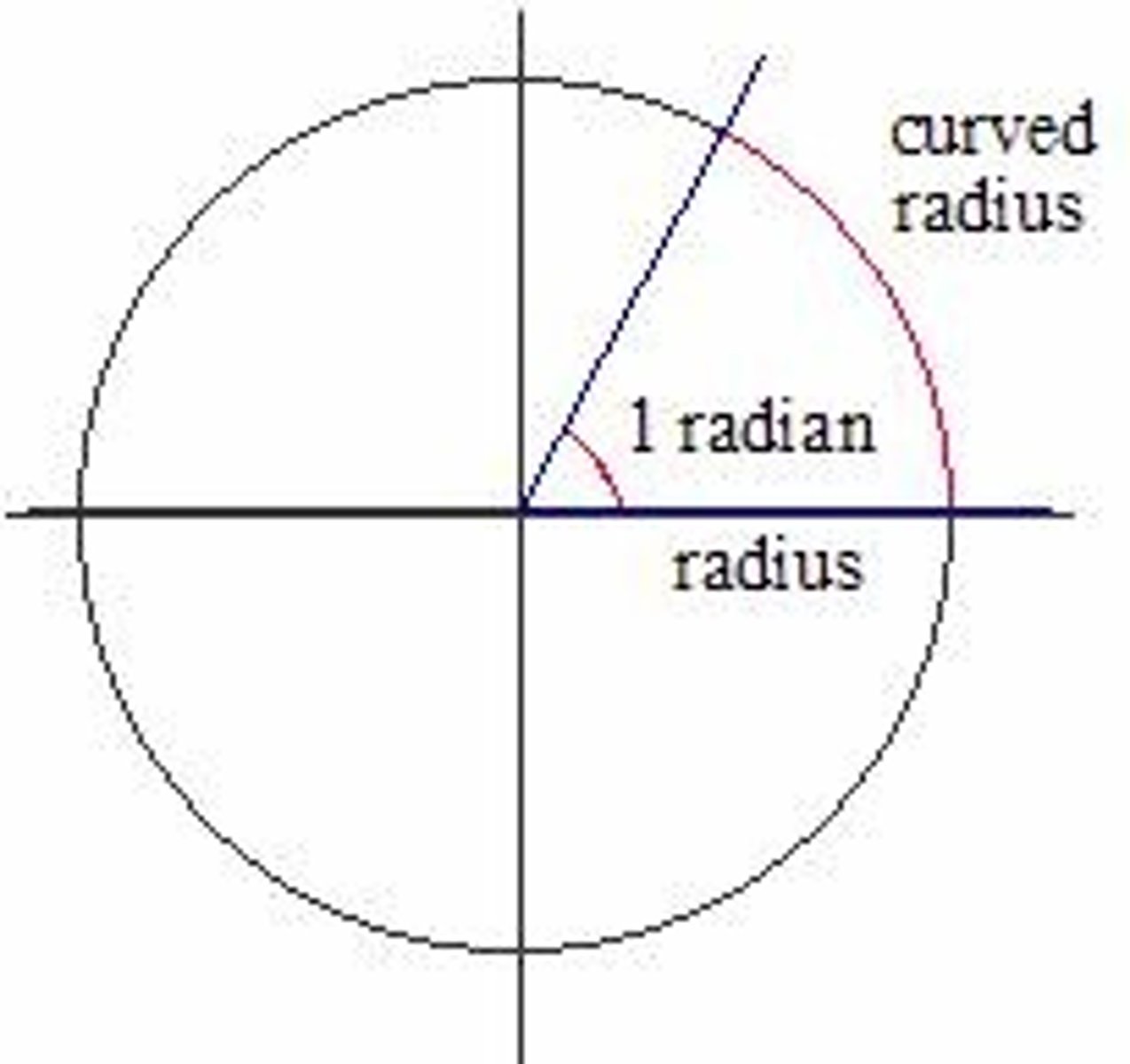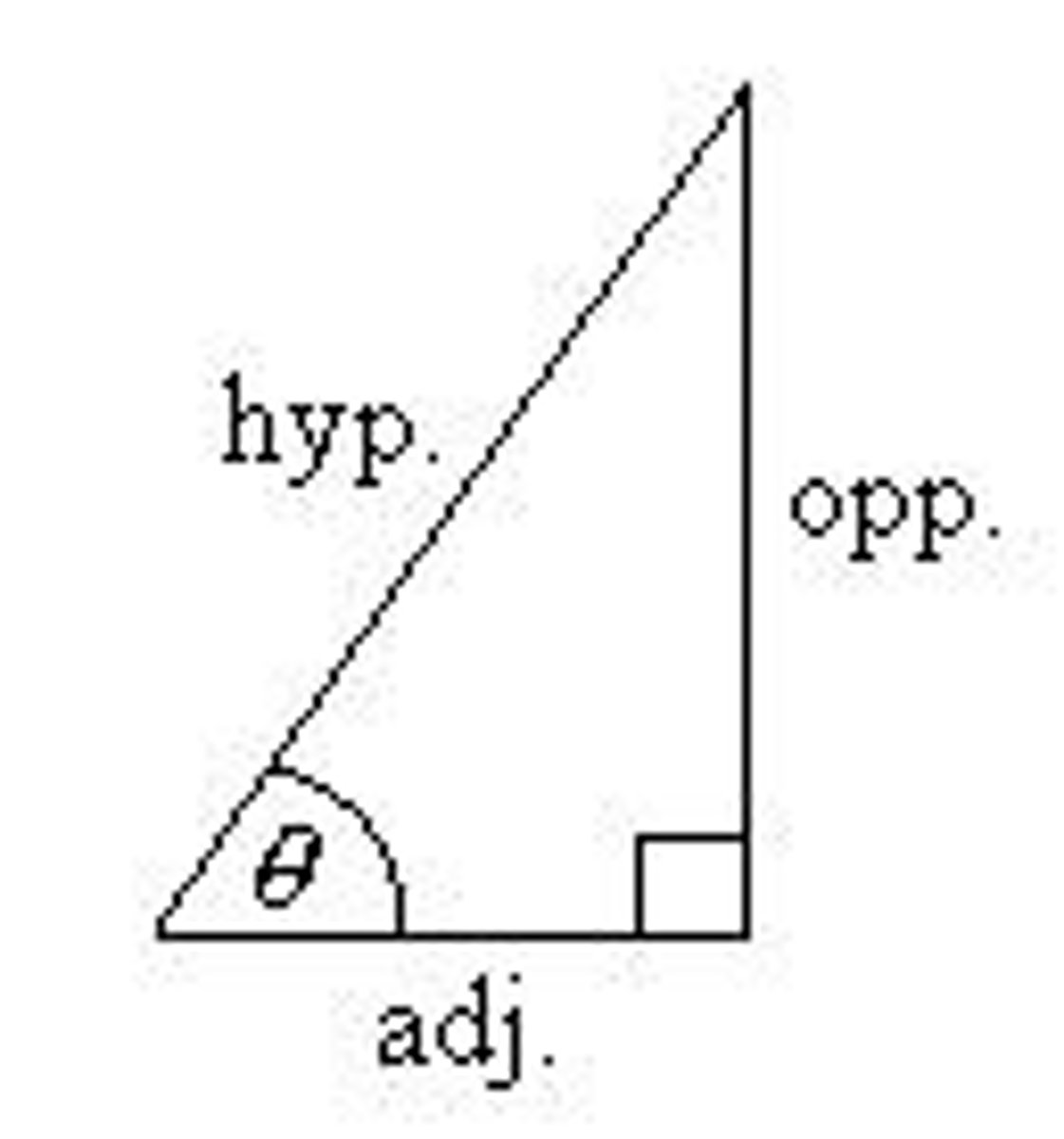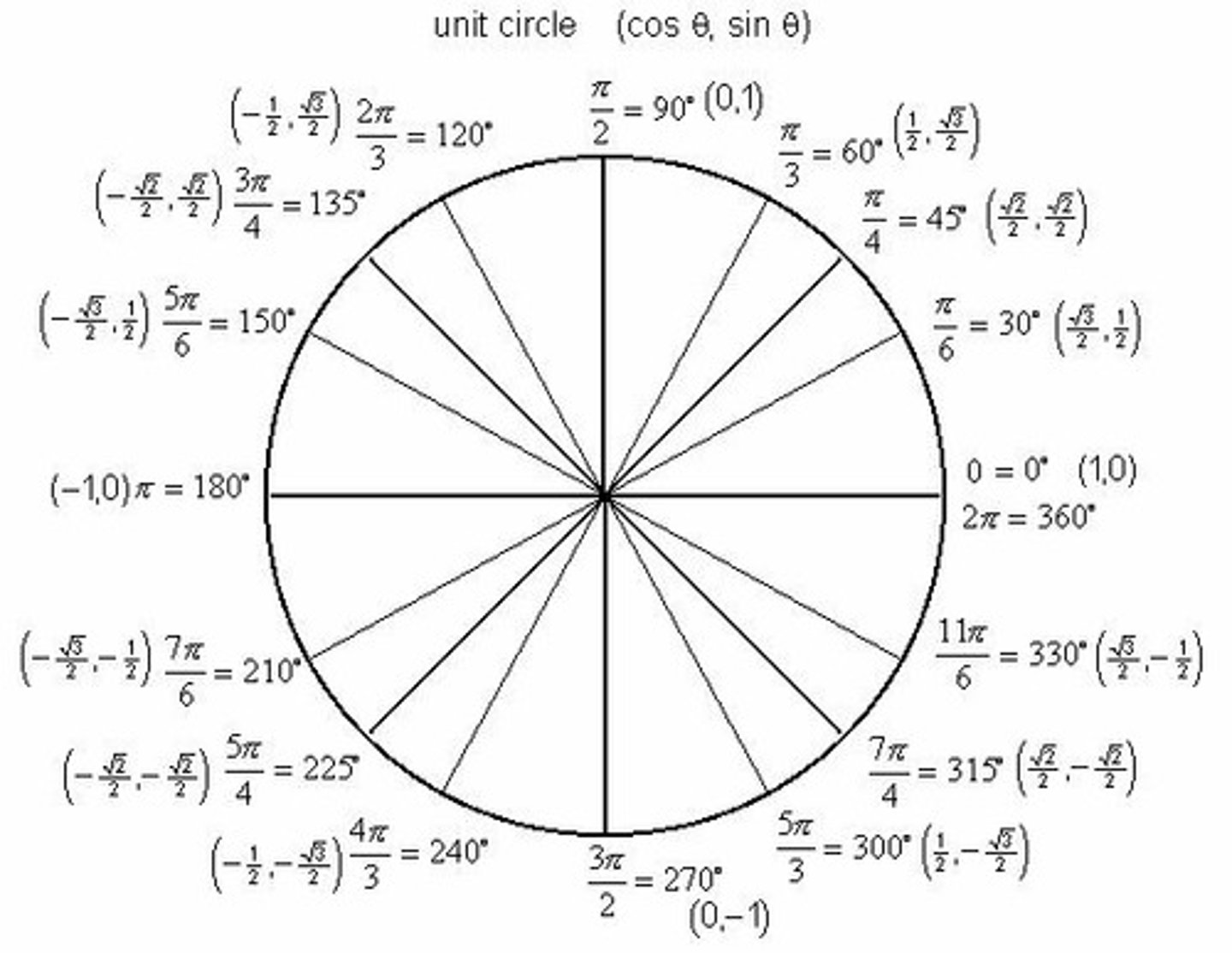Comprehensive Trigonometry Review: Unit Circle, Identities, Graphs, and Formulas
1/96
There's no tags or description
Looks like no tags are added yet.
Name | Mastery | Learn | Test | Matching | Spaced |
|---|
No study sessions yet.
97 Terms
Angle Measure
Angles can be measured in 2 ways, in degrees or in radians.

Degrees
Degrees will always have the degree symbol above their measure, as in '45°'.
Radians
Radians are real numbers without any dimensions, so the number '5' without any symbol represents an angle of 5 radians.

Positive Angles
Positive angles start on the positive x-axis and rotate counterclockwise.
Negative Angles
Negative angles start on the positive x-axis and rotate clockwise.
Conversion from Radians to Degrees
The official formula is θ = radians × (180/π).
Conversion from Degrees to Radians
The conversion formula is radians = θ × (π/180).
1 Radian
1 radian is approximately 57.30 degrees.
Arc Length Formula
Arc length = (radius) × (degree measure in radians).

Arc Length Variation
s = rθ, where s is arc length, r is radius, and θ is in radians.
Trigonometric Ratios
The six trigonometric ratios are defined based on a right triangle and the angle θ.
SOH CAH TOA
sinθ = opp/hyp, cosθ = adj/hyp, tanθ = opp/adj.
Reciprocal Functions
cscθ = hyp/opp, secθ = hyp/adj, cotθ = adj/opp.
Finding Trigonometric Functions
To find the exact values of all 6 trigonometric functions, determine the sides of the triangle.
Adjacent Side
The side adjacent to angle θ in a right triangle.
Opposite Side
The side opposite to angle θ in a right triangle.
Hypotenuse
The hypotenuse is the longest side of a right triangle.
Special Angles
The special angles include 30° (π/6), 45° (π/4), and 60° (π/3).

Triangle for 30°
For 30°, the triangle is defined by D = π/6.
Triangle for 45°
For 45°, the triangle is defined by D = π/4.
Triangle for 60°
For 60°, the triangle is defined by D = π/3.
Sine
sin(θ) = opp/hyp
Cosine
cos(θ) = adj/hyp
Tangent
tan(θ) = opp/adj
Cosecant
csc(θ) = hyp/opp
Secant
sec(θ) = hyp/adj
Cotangent
cot(θ) = adj/opp
Domain of Sine and Cosine
All real numbers
Range of Sine and Cosine
[-1, 1]
Periodicity of Sine and Cosine
sin(t + 2πn) = sin(t) and cos(t + 2πn) = cos(t) for any integer n
Special Angle 30°
D = π/6
Special Angle 45°
D = π/4
Special Angle 60°
D = π/3
Value of sin(0)
0
Value of cos(0)
1
Value of tan(0)
0
Value of sin(π/2)
1
Value of cos(π/2)
0
Value of tan(π/2)
undefined
Value of sin(π)
0
Value of cos(π)
-1
Value of tan(π)
0
Value of sin(3π/2)
-1
Value of cos(3π/2)
0
Domain of sine and cosine functions
All real numbers; graphs continue to the left and right in the same sinusoidal pattern.
Range of sine and cosine functions
[−1, 1]
Amplitude
The coefficient in front of the sine or cosine function that stretches or shrinks its y-values.
Example of amplitude
For y = cos(x), amplitude = 1; for y = 2cos(x), amplitude = 2; for y = 1/2 cos(x), amplitude = ½; for y = -2cos(x), amplitude = 2 with reflection in x-axis.
Period
The length of the function's cycle, which can change with a coefficient in front of x.
Standard period for sine and cosine
The usual cycle is on the interval [0, 2π].
Period formula with coefficient b
The period of y = a sin(bx) and y = a cos(bx) is found by dividing 2π by b.
Effect of b > 1 on period
Causes the graph to shrink horizontally because the period will be less than 2π.
Effect of 0 < b < 1 on period
Causes the graph to stretch horizontally making the period greater than 2π.
Key points of the graph
Found by dividing the period length into 4 increments.
Example of graphing sine function
Sketch a graph of y = (1/4)sin(2x) by hand; amplitude is 2.
Example of graphing cosine function
Sketch the graph of y = -8cos(10x); amplitude is 8, reflected in x-axis.
Period for y = -8cos(10x)
The period is found by solving the inequality 0 ≤ 10x ≤ 2π, resulting in 0 ≤ x ≤ π/5.
Translations or Phase Shift
Determined by setting up an inequality for the function and solving for x.
Example of phase shift
For y = 0.25cos(4x + 2), amplitude = 0.25, period = 2π, determine the phase shift interval.
Phase Shift
The horizontal shift left or right for periodic functions, determined by the value of c in the function f(x) = a sin(b(x - c)) + d.
Vertical Shift
The upward or downward displacement of a graph, determined by the value of d in the function f(x) = a sin(b(x - c)) + d.
Reciprocal Identities
Identities that express trigonometric functions in terms of their reciprocals, such as sin(u) = 1/csc(u).
Quotient Identities
Identities that express tangent and cotangent in terms of sine and cosine, such as tan(u) = sin(u)/cos(u).
Even Identities
Identities that show that certain functions are even, such as cos(-u) = cos(u).
Odd Identities
Identities that show that certain functions are odd, such as sin(-u) = -sin(u).
Pythagorean Identities
Identities that relate the squares of sine, cosine, and tangent, such as sin²(u) + cos²(u) = 1.
Critical Points
Points on the graph where the derivative is zero or undefined, indicating potential maxima, minima, or points of inflection.
Graphing Function
The process of plotting the values of a function on a coordinate system to visualize its behavior.
Dotted x-axis
A temporary line drawn to help visualize critical points before determining the final position of the x-axis.
Solid x-axis
The final position of the x-axis after determining where it should fall based on the graph's critical points.
Function f(x)
An expression that defines a relationship between an input x and an output, such as f(x) = 4/3 sin(2x).
Reflection
A transformation that flips a graph over a specific axis, often altering the amplitude.
Interval
A range of values on the x-axis over which a function is defined or analyzed.
Unit Circle
A circle with a radius of one, centered at the origin of the coordinate plane, used to define trigonometric functions.

SOLUTION
The answer or method used to solve a mathematical problem, often including steps taken to arrive at the answer.
Function's Graph
A visual representation of the relationship between the input and output of a function.
Trigonometric Functions
Functions that relate the angles of a triangle to the lengths of its sides, including sine, cosine, and tangent.
Vertical Shift by 4 units
A transformation of the graph that moves it up 4 units in the y-direction.
Angle Sum Formula for Sine
sin(α + β) = sin(α)cos(β) + cos(α)sin(β)
Angle Difference Formula for Sine
sin(α - β) = sin(α)cos(β) - cos(α)sin(β)
Angle Sum Formula for Cosine
cos(α + β) = cos(α)cos(β) - sin(α)sin(β)
Angle Difference Formula for Cosine
cos(α - β) = cos(α)cos(β) + sin(α)sin(β)
Angle Sum Formula for Tangent
tan(α + β) = (tan(α) + tan(β)) / (1 - tan(α)tan(β))
Angle Difference Formula for Tangent
tan(α - β) = (tan(α) - tan(β)) / (1 + tan(α)tan(β))
Double Angle Formula for Sine
sin(2u) = 2sin(u)cos(u)
Double Angle Formula for Cosine
cos(2u) = cos²(u) - sin²(u)
Double Angle Formula for Tangent
tan(2u) = 2tan(u) / (1 - tan²(u))
Power Reduction Formula for Sine
sin²(x) = (1 - cos(2x)) / 2
Power Reduction Formula for Cosine
cos²(x) = (1 + cos(2x)) / 2
Product to Sum Formula for Sine
sin(α)sin(β) = 1/2 [cos(α - β) - cos(α + β)]
Product to Sum Formula for Cosine
cos(α)cos(β) = 1/2 [cos(α - β) + cos(α + β)]
Sum to Product Formula for Sine
sin(x) + sin(y) = 2sin((x + y)/2)cos((x - y)/2)
Sum to Product Formula for Cosine
cos(x) + cos(y) = 2cos((x + y)/2)cos((x - y)/2)
Trigonometric Equation Example
Solve the equation 3 csc²(x) + 3 = 0 on the interval [0, 2π).
Unit Circle and Sine
Sine is defined by the y-coordinates on the unit circle.
Identifying Angles on Unit Circle
Identify angles where the y-coordinate is -3/2.
Solutions for Trigonometric Equation
The solutions are x = 4π/5 and x = 3π/3.